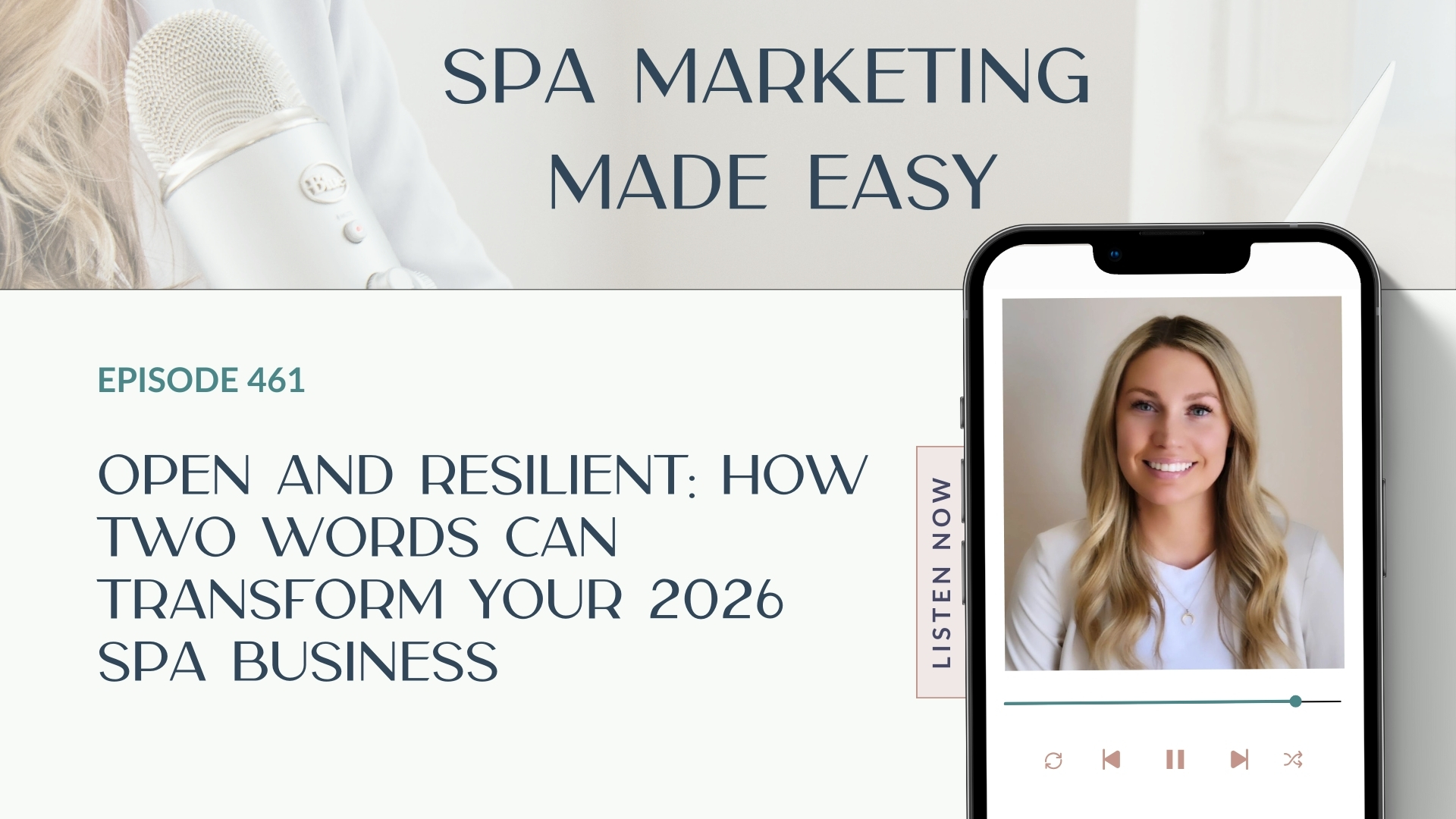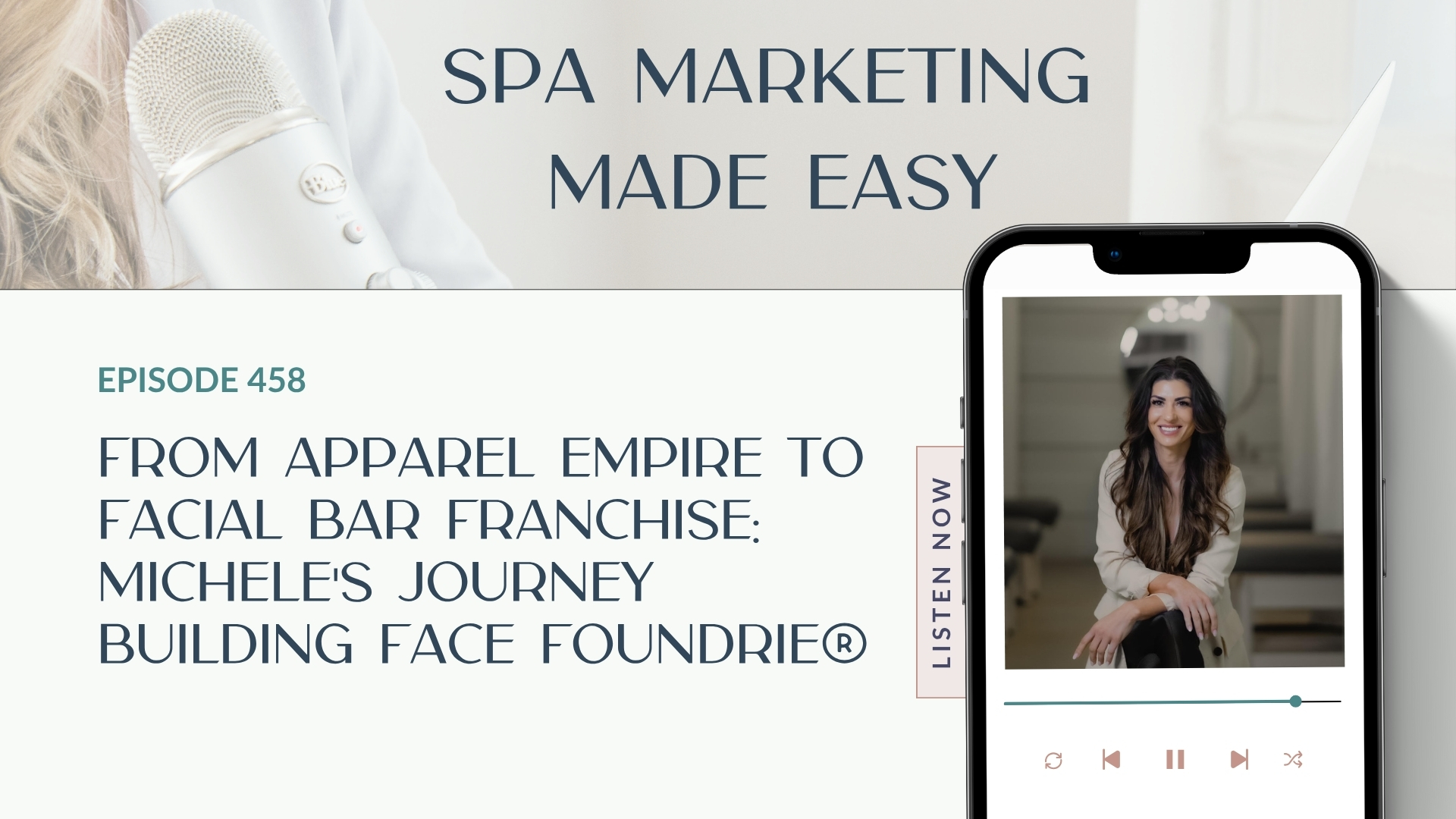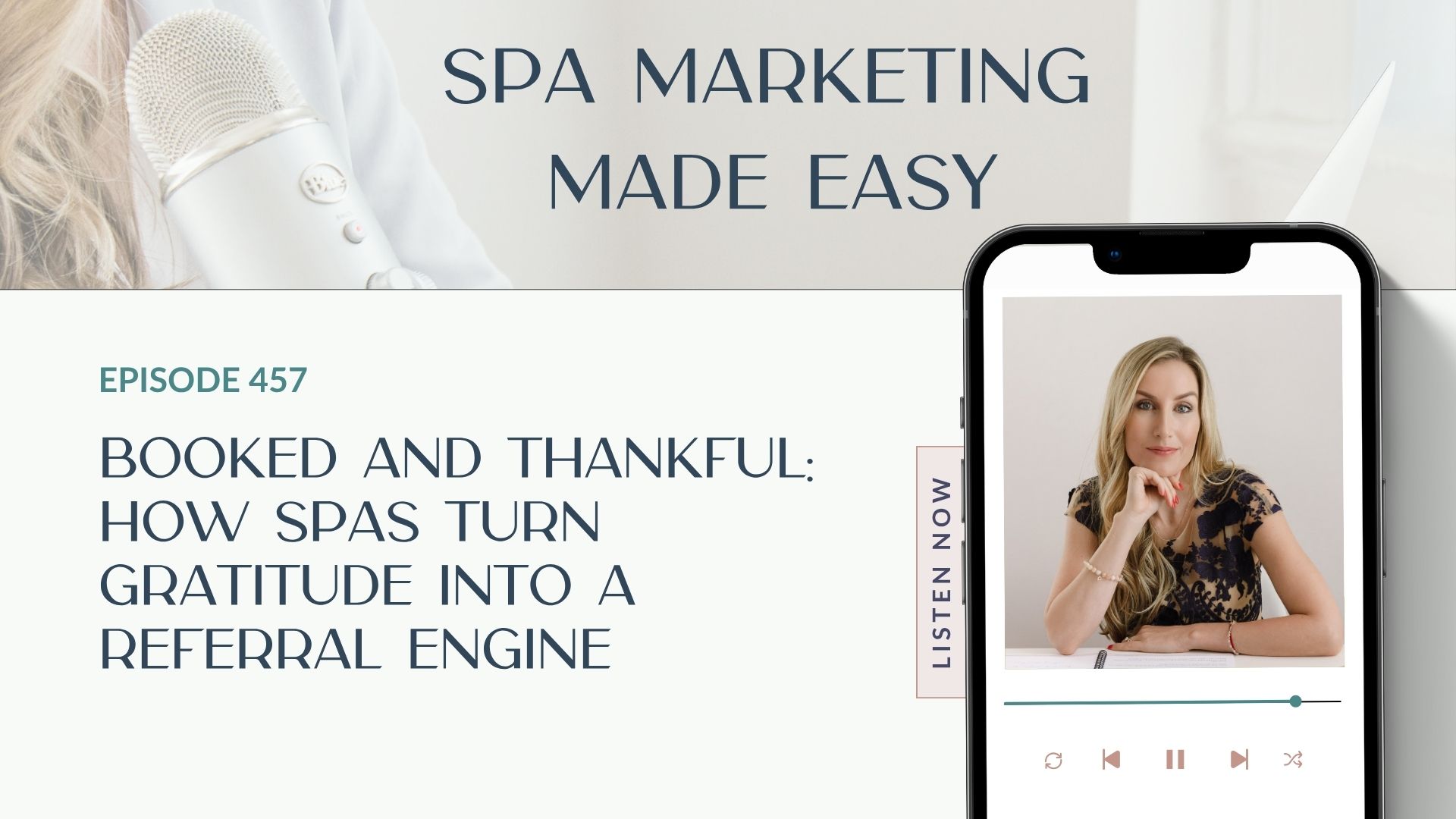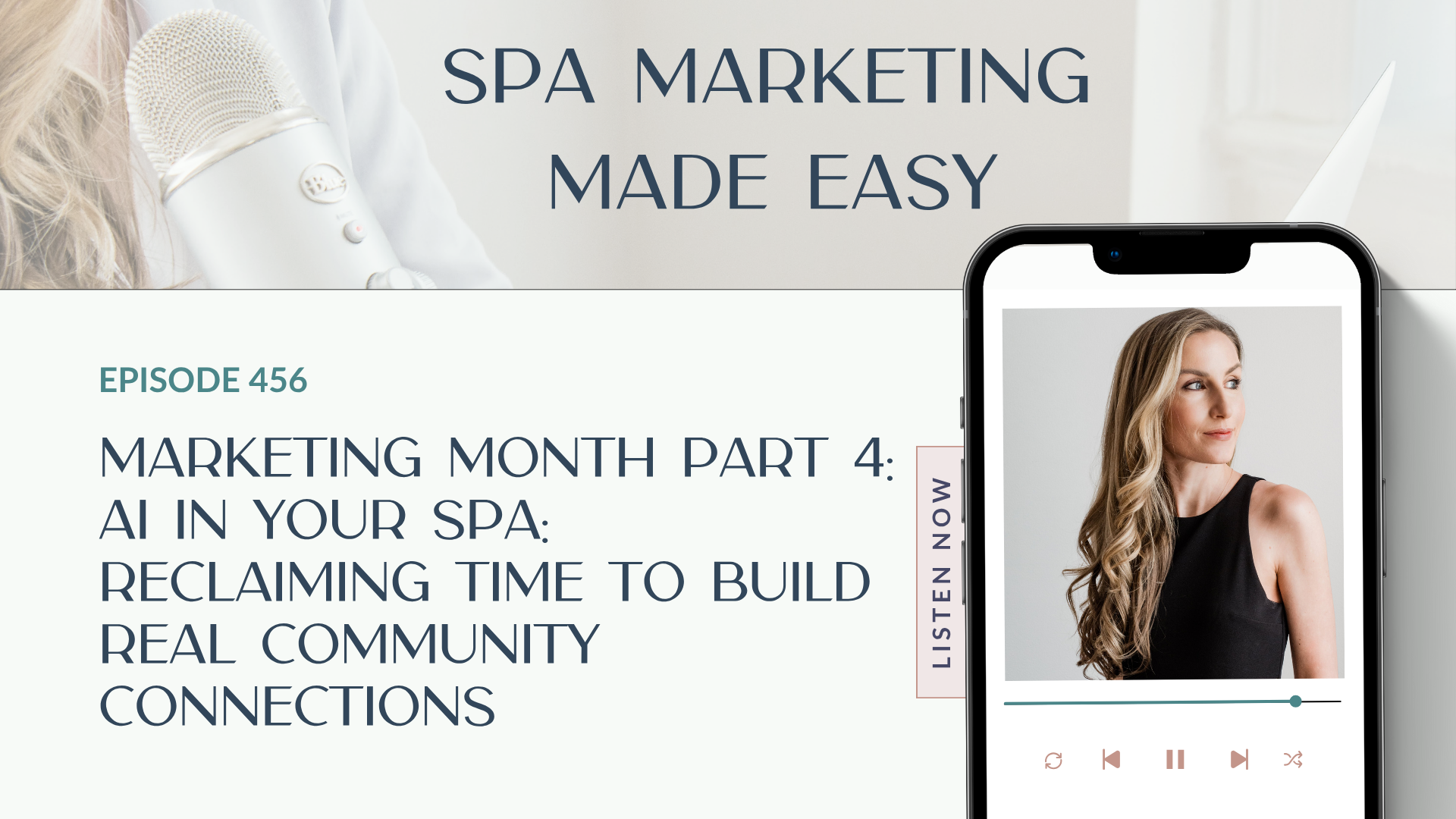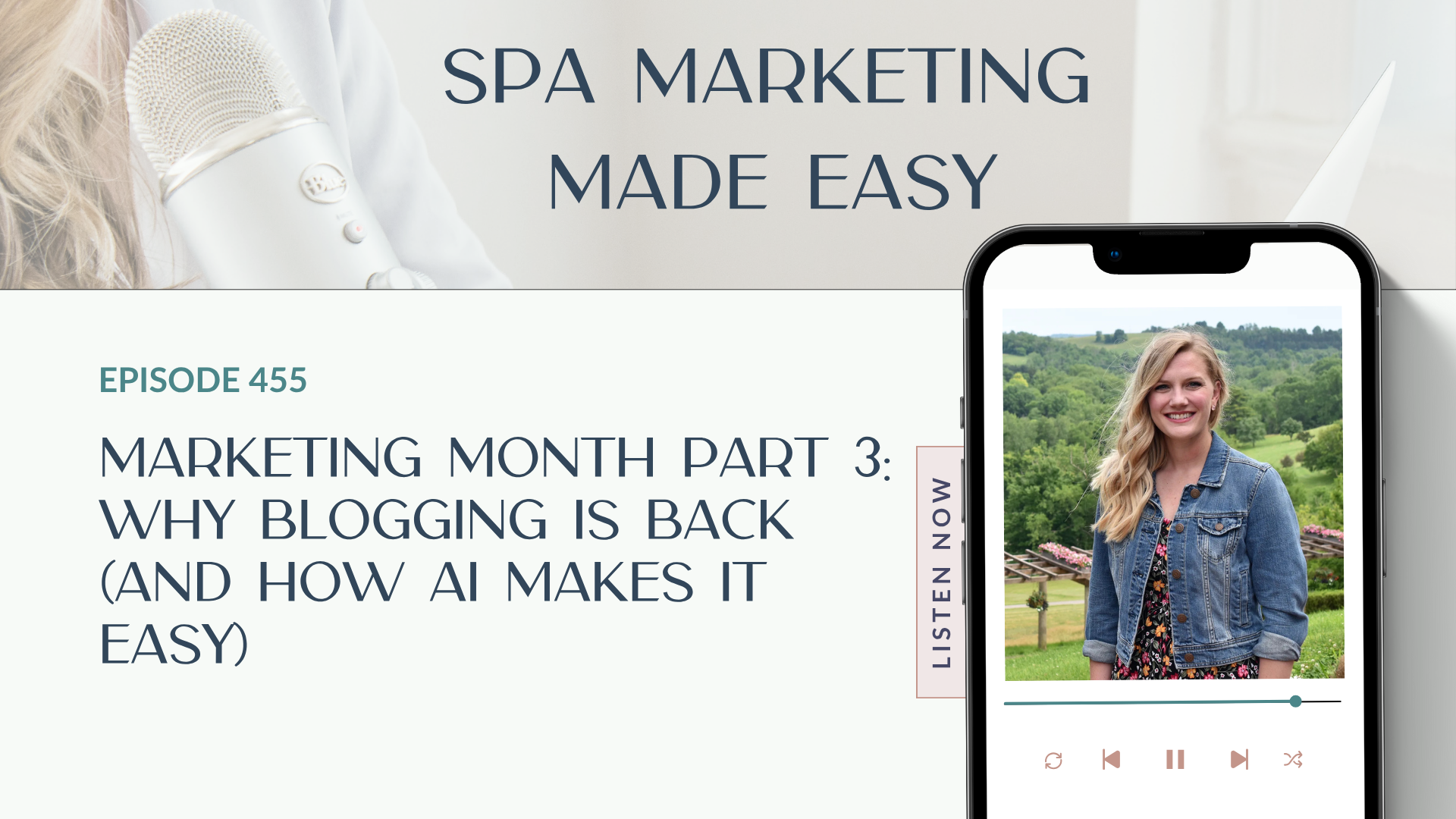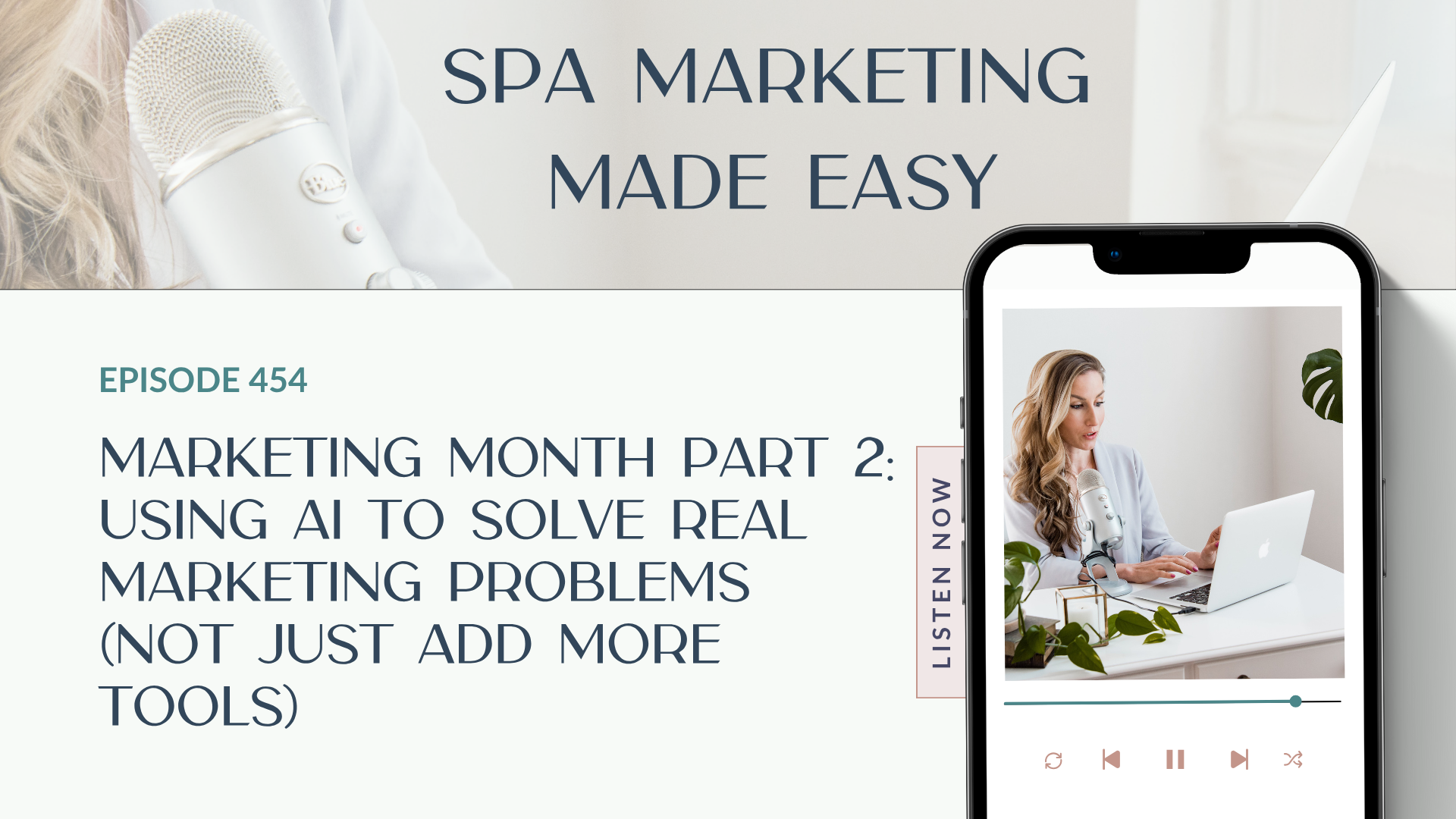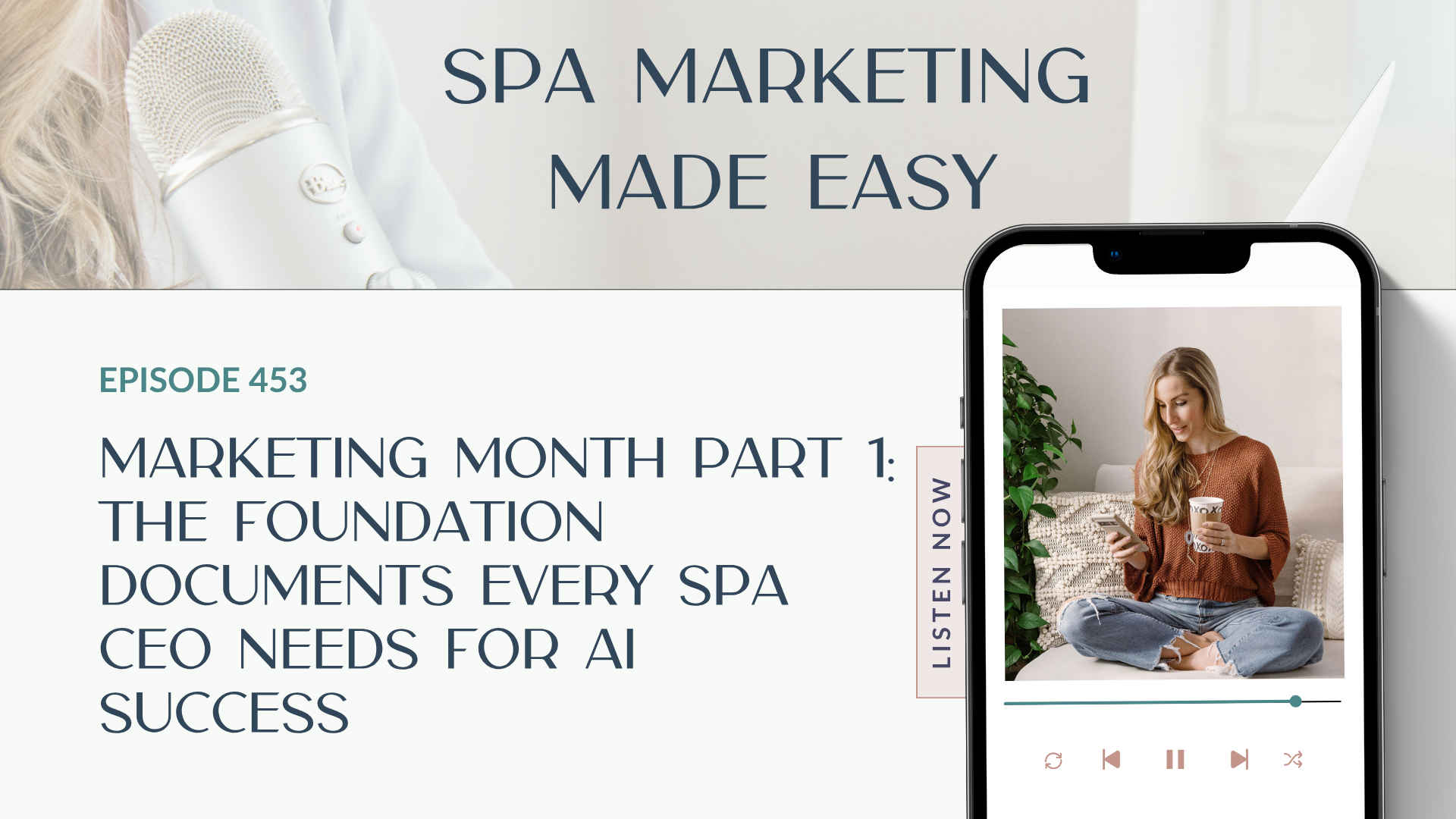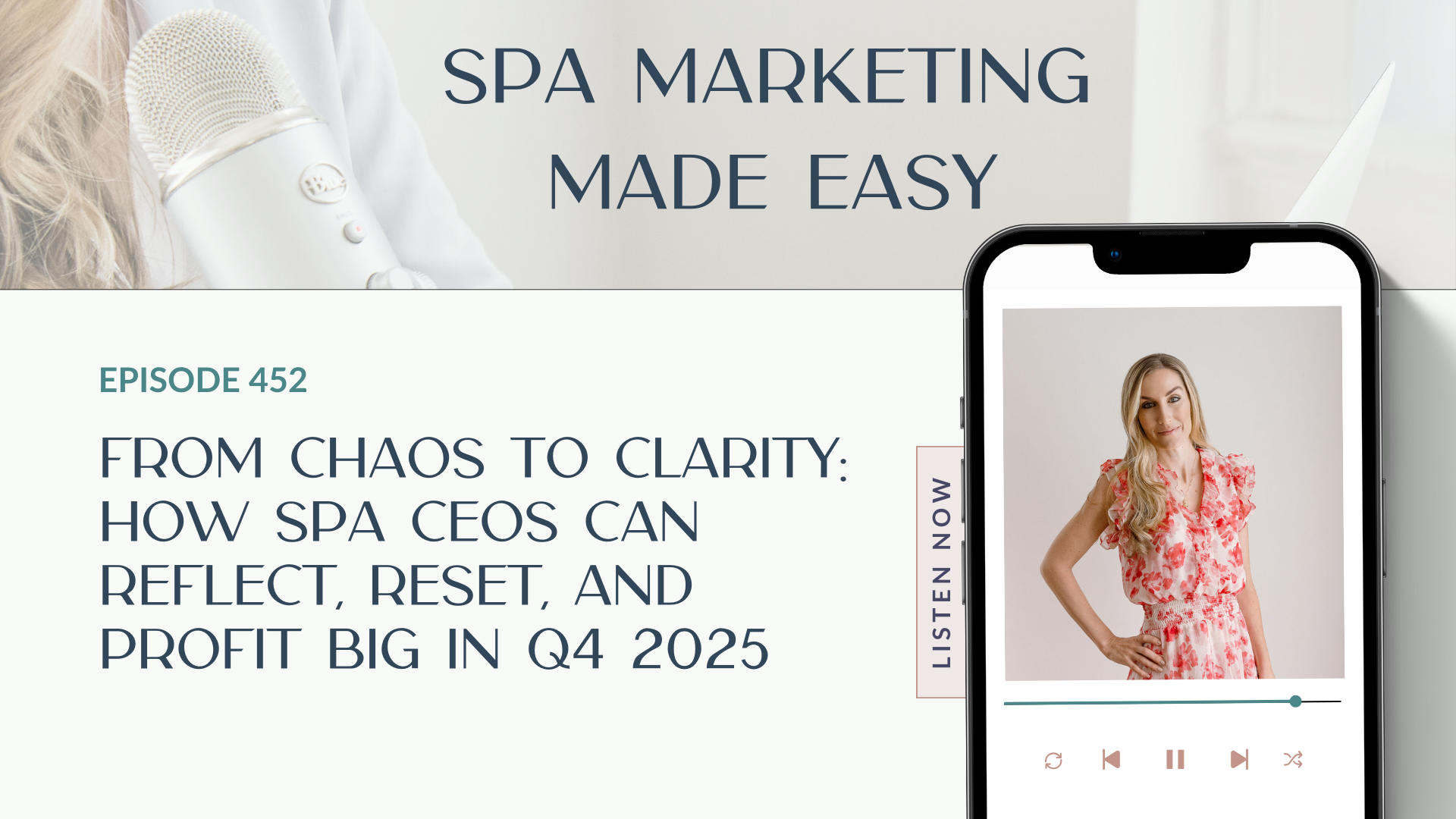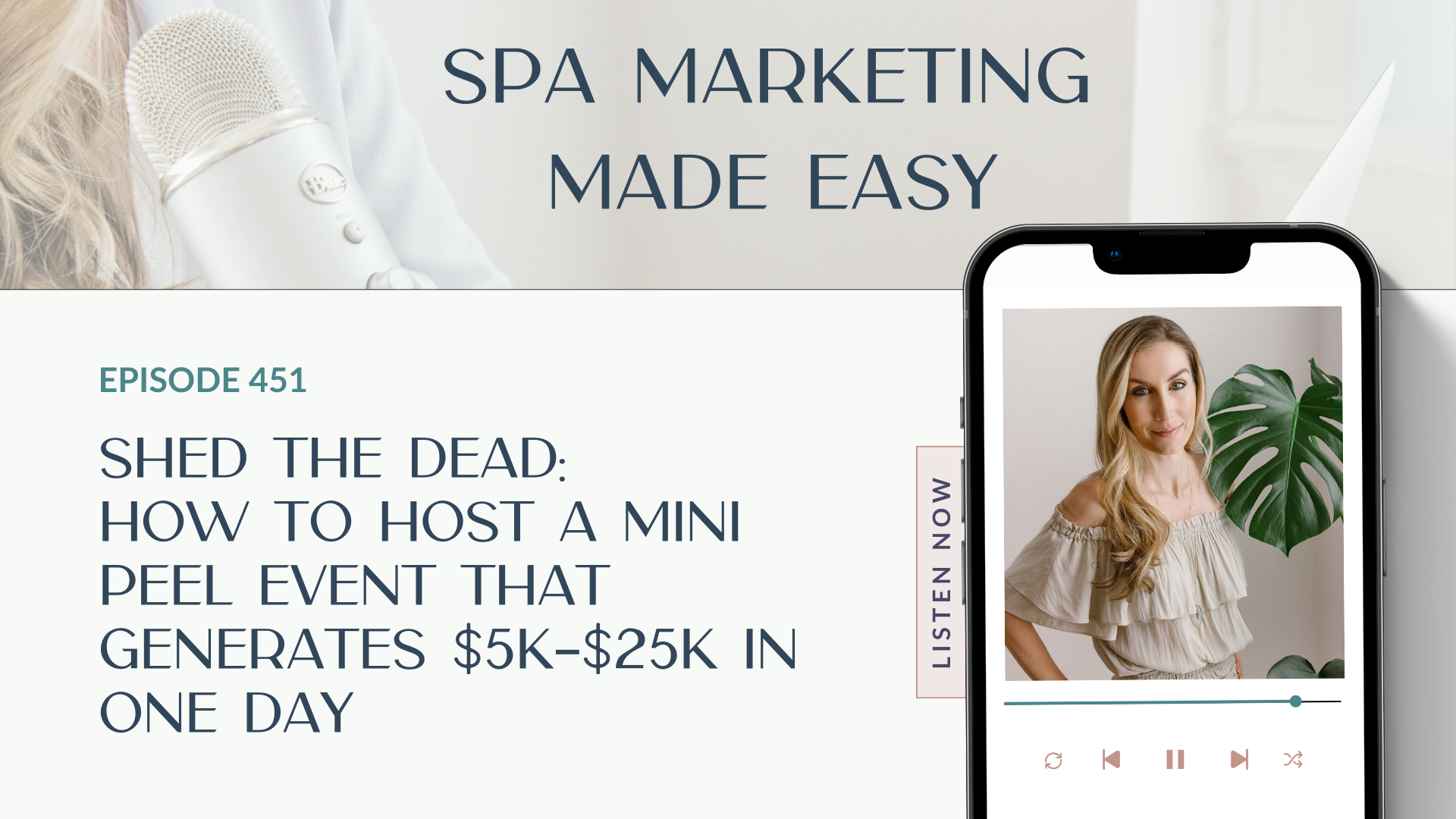One Word Can Change Everything: Setting Your 2026 Spa Business Theme
If 2025 felt like a year where nothing made sense but somehow everything changed, you’re not alone.
In this episode of Spa Marketing Made Easy, I sit down with Addo Coach, Sara Sykes-Moore to talk about something simple but powerful: choosing a word of the year. This isn’t about resolutions that fade by February. It’s about selecting an anchor, a theme that guides your decisions, your mindset, and your business strategy for the entire year ahead.
For me, that word is OPEN.
After 20 years in the aesthetics industry, it would be easy to fall into the trap of “this is how we’ve always done it.” But 2025 taught me that the businesses thriving right now are the ones willing to test, adapt, and embrace new possibilities. Being open means welcoming new partnerships, new technologies like AI, and new ways of approaching client acquisition. It means admitting I’m a beginner at some things (like running a farm) and being okay with that. Most importantly, it means refusing to let comfort zones dictate my growth.
Sara chose RESILIENCY as her word, and honestly, after hearing her story about a deer literally running through her house, it’s the perfect fit. She’s someone who can be handed chaos and still reframe it into something productive. That’s not just a personality trait; it’s a skill. And it’s one every spa CEO needs to develop.
Entrepreneurship is your greatest personal development classroom. Apart from raising children, nothing will push you harder to grow, solve problems, set boundaries, and build confidence than running a business. You’ll be judged. You’ll make mistakes. You’ll want to quit. And the ability to bounce back, to reframe, to keep moving forward? That’s what separates the spa owners who build something sustainable from the ones who burn out.
We’re entering 2026 in a completely different landscape than where we started this industry journey. Consumer behavior has shifted. AI is no longer optional. The strategies that worked six months ago might not work today. But that’s not a bad thing. It’s an invitation to evolve.
If you’re feeling stuck, overwhelmed, or uncertain about the year ahead, I want you to ask yourself: what’s the one word that would guide me toward the version of myself I want to become?
Maybe it’s clarity. Maybe it’s courage. Maybe it’s discipline or ease or abundance. Whatever it is, write it down. Put it somewhere you’ll see it daily. Let it become the lens through which you evaluate opportunities, set boundaries, and make decisions.
Your business is more elastic than you think. One setback won’t break you. One pivot won’t ruin you. In fact, most of the time, your greatest growth comes from the moments that felt the hardest.
So as we close out this year and step into 2026, I’m inviting you to get intentional. Reflect on what 2025 taught you. Decide what you want 2026 to feel like. And choose the word that will anchor you through both the wins and the challenges ahead.
This episode is a conversation about resilience, openness, and the power of reframing your mindset. Tune in, take what resonates, and let’s make 2026 the year we stop reacting and start leading with clarity and purpose.

Subscribe to Our Newsletter
Stay up-to-date with our email newsletter to receive important updates, news, and offers!
IG / @addoaesthetics
WEB / addoaesthetics.com
YOUTUBE / @addoaesthetics
LINKEDIN / @addoaesthetics
About Your Host, Daniela Woerner
Daniela Woerner is the founder of Addo Aesthetics and creator of the Growth Factor® Framework, a proven system that’s helped hundreds of spa owners build profitable, systemized businesses. With nearly 20 years in the aesthetics industry, she transforms overworked aesthetic professionals into confident Spa CEOs through strategy, systems, and soul led support. Daniela is also the host of Spa Marketing Made Easy, a top ranked podcast with over 1 million downloads, where she shares real world strategies to help spa professionals grow with clarity and confidence.
PODCAST TRANSCRIPT:
Hey Welcome to the Spa Marketing Made Easy Podcast. I am Daniela Woerner and I am your host. This is a show for esthetic professionals ready to grow their business with proven strategies and systems. So whether you are a solo aesthetician or you are running a medical spa with a team of providers. This show is designed to give you tactical strategies and advice to help you build a profitable and sustainable spa without the overwhelm, and today we are talking about something that makes a lot of spa owners really uncomfortable, but it’s part of growing your business. It’s part of business sustainability, and that is increasing prices. And we’re talking specifically about increasing prices in January. And I know that this can bring up a lot of anxiety, especially with current in the current economic climate, you might be thinking, Gosh, I’m going to lose all of my clients, or my market just won’t support higher prices, or I’m already the most expensive spot in the in my town. I have heard it all before. I’ve been there myself with my own business in questioning, you know, what are, what are the appropriate prices that the market will support. But this is what you’ve got to understand. If you are not raising prices regularly, meaning, like on an annual basis, you’re actually going to be putting yourself out of business little by little.
And I know that sounds dramatic, but it’s true, and that’s why I wanted to have this episode today, to really break it down, and, more importantly, give some insight on what to actually do about it. So this is going to be a pretty tactical episode. We are not going to just talk about like, why you need to raise prices. We’ll talk about it briefly, but I want to walk you through how you actually do it okay? So we are going to have some communication templates. We’re going to have some AI prompts. If you just send us a DM on Instagram, we’ll make sure to get those to you. So again, we’re going to have a email template, we’ll have some social templates, and we will have some AI prompts. All you have to do is send us a DM on Instagram, let us know you want those, and we will message them right over Okay, so, oh, and the other thing that’s included in there, last but not least, is the pushback scripts. Like, how do you handle when your clients and or your team feel uncomfortable with a price increase, like, how do we respond to that?
Okay, so we have some scripts to help you with that as well. So if you’ve been putting this off or you’ve been scared to pull the trigger, you just don’t even know where to start. Listen in. We’re going to cover a lot today. Okay, so let’s start with why. Okay, so we want to, I want to make sure that we’re all on the same page as far as understanding why this is such an important part of business. Now, every single year, your costs are going up, so you’re probably in the middle right now, if you’re, it’s November as I’m recording this, and you’re probably getting letters and emails and things from your product vendors that are increasing their prices, which means a price increase is going, you know, being passed on to you. Your insurance might be going up. Your rent might be going up. If you have employees, they may be asking for and deserve raises to keep up with the cost of living. Your cost of living may be increasing. So if you are not increasing prices, what’s actually happening? Your profit margin is shrinking. You are making less money while working the same amount or more, and that is not good. At some point that will become completely unsustainable. This is basic business math. Okay, so if your cost increased by 5% and your prices stay the same, everything else just stays the same, you just lost 5% of your profit margin. So do that for three years in a row, and you’re in serious trouble. Okay, but I can’t raise my prices. My clients can’t afford it. I’m going to lose everybody. You will lose some people, okay? Like, I’m not going to sugarcoat it. There’s nothing to sugarcoat you will lose people when you raise your prices. That is a part of doing business, okay? But this is also something that’s true some of those that natural attrition that happens when you increase the prices you’re creating space to attract you’ll have more space to attract an ideal client that will that can and will be able to pay. Eight those prices Okay, the ones that are going to fall off are the ones that are more price sensitive, that are going to price shop, that are going to they’re just more price sensitive and or they’re not valuing your expertise in the same way as your ideal client is, as you may desire from your ideal client, okay, and it’s important to I know this can be uncomfortable. I know it can be scary. I know it can be uncertain. But like, we are not running charities here, we are running businesses to help our community, to help impact our employees, to help women look and feel their best. Okay, so we want to make sure that we can be sustainable long term. All right, if you are only competing with price, you will slowly, slowly run your business into the ground, okay? And then you’re not going to be able to continue to help your employees, your community, all of the people that you have this this desire to help, and on top of that, you’re going to be burnt out and resentful, okay? So you’ve got to make sure that you are charging appropriately to be able to offer your goods and services, to be able to pay your staff, to be able to pay yourself. Now, if you it’s it’s pretty normal for spa owners, even though I am not a huge fan of this, it’s pretty normal for spa owners and business owners in general to not pay themselves in the beginning years of the business. It’s a, you know, kind of hopefully we are able to pay ourselves a higher amount, amount down the line, so that we can, you know, make up for those beginning years when we were not able to pay ourselves our value or our worth. But we don’t want to continue that phase of the business for years and years and years. There’s a certain point where burnout and exhaustion and resentment will set in. Okay? So you’ve got to pay yourself you have a certain level of expertise, your time is incredibly valuable, and it’s super, super important for the longevity and health of the business. Okay, so we’re not raising prices because we are greedy. We are raising prices because our business needs to be profitable in order to survive and thrive. So there’s two different types of price increases. Okay. So scenario one, your prices might already be where they need to be. They’re in line with your market, they’re covering your costs, they have appropriate profit margins, and you just need to be keeping up with inflation. Okay, if this is the case, easy peasy. We’re looking at like a two to 5% increase annually. Okay, so this is your standard incremental increase. It’s small enough that most clients are not going to bat an eye, but it’s big enough to maintain your profit margins as your costs increase.
Remember, even a $5 increase on a service can end up being 1000s of dollars in your bank account over the course of the year. Now that’s you know, scenario number one, where we all want to get to the point where, where that is our big change. What we’re going to talk about, for the most part today, is scenario number two, and that’s where your prices are not where they need to be. Maybe you started to load, maybe you never corrected it, maybe you haven’t raised prices since you started your business. Maybe you’ve been afraid to charge what you’re worth. In this case, we’ve got the what I recommend as the rip the band aid off approach. Okay, so we are going to make one big jump, and we’re going to get our prices where they need to be. This is, this can be a shock. This can be a, you know, like a, oh my gosh. That’s a really big increase. But in my opinion, in my experience, and I’ve seen this happen with several spas over the past 12 years that we’ve been in business, is that it’s much better to do the rip the band aid approach, rather than increasing and then increasing and then increasing and then increasing. If we’re constantly increasing it multiple times throughout the year. That’s going to wear down the trust of your clients or patients to think, gosh, like, what’s going on every single time I come in, there’s a price increase. We don’t want to create that energy. We want predictability, and it’s normal and predictable. Know that every January, our prices increase by a small amount. Okay, so I, you know, actually last week, I was talking with one of our coaches, and she was reminding me about a client who was coaching with us probably four or five years ago, she was incredible, someone who I consider a friend at this point, and she was, it was one of our, like, very early growth factor coaching calls, and she would come on the call and she would just be complaining about lashes. She was not happy doing lashes. She felt it was a waste of her time. She felt it was so tedious. It was just like it was a huge pain point. It was the topic of almost every call. And I had to get down to the what was it?
Did she not enjoy doing lashes? Or did she just, was it like a burden on her time? And so we went through, you know, some coaching. We went through and figured some things out, and we actually increased her lash prices by $100 so, I mean, that’s a pretty significant increase. And I think she was at 200 and we increased to 300 for the full set. And this was like, you know, again, like about five years ago. And once we increase the prices, she had no problem doing lashes. She felt like she was making great money. She felt like it was it was worth her time, and so it was not as big of a problem. And the reason I’m telling you that story now is because it was obviously a big, scary jump to increase prices by $100 I mean, that is a significant increase. And I think she lost three people out of like and she was primarily, primarily a lash business. So I think she lost three people. She had one that was really upset, two people that just said, you know, I can’t afford that, but everybody else stayed. Everybody else stayed. Now, I’m not saying that that’s going to happen in your business. It’s going to be different in everybody’s business, but you don’t know until you put a strategy into effect, right? You don’t know what your clients or patients value. You don’t know what it is worth to them, okay, so we need to make sure that we are pricing fairly and appropriately to cover the cost of our business, to ensure that we have a reasonable profit margin that we can actually pay ourselves. Okay, but we’ve got to get those prices in line so that you can run the sustainable business. Okay? So once we make this big jump, yes, you are going to lose some people, right? But then every year after, we are only going to have to increase by two to 5% which makes it a very easy pathway moving forward. Okay, now, in the past 12 years in business, we’ve worked with over 1700 spas, and over 600 of them have gone through our growth factor Framework Program. And I can tell you that pricing is something that we talk about a lot. In fact, it’s one of the very first things that we talk about is the cost of treatment and profitability tracker. Because if I don’t know what your pricing is, I’m not going to be able to give you advice on what services we should focus on. Or if you’re feeling like, gosh, I’m fully booked and my providers are booked, but there is literally no money left over at the end of the month. There’s, you know, we’ve got to understand the right problem to solve, and we have to get into the data to see that. So the spas that I’ve worked with that are high multi, six or seven figure spas, they are dialing in their pricing on a granular level, and they are making sure that their profit margins are at an appropriate level. Now I’m going to add in a bonus tip here, because we are in interesting economic times, right? Certain places I’m seeing that are just thriving and doing incredibly well. Other places are very much struggling. Okay, so we’ve got to you’ve got to understand where you’re at, and if you’re in a place that it truly is, a community that is struggling financially, then you’ve got to look at other ways, in smart ways, that you can adjust your margins.
Can you shorten the amount of time. Are there ways that you can lower your back bar expenses? We’ve got to pull some different levers to make sure that we can get our our profit margins in the appropriate place. Okay? So it can be a combination of levers that we’re pulling, but we need to look at that cost of treatment and. Profitability tracker and get our margins as close to 80% as possible. Okay, so when we are looking at what I’m talking about, our you know, 80% margins the cost of treatment and profitability tracker is something that’s in growth factor fundamentals. This is our kind of foundational program for spas that want to build systems based businesses, and having your systems in place, it’s so much easier to scale right when we have these things standardized. So cost of treatment and profitability tracker is in there, and what we’re doing is going through and listing out in a granular fashion, the consumables that are being used in a service. So a derma plane blade, cotton rounds four by fours, cleanse, you know, two bumps of cleanser, a pair of gloves like you’re listing out the actual consumables to understand what the pricing is, and then we’re looking at your payroll included in that. So for this, the purposes of this tracker, we are only looking at consumable cost and payroll, because we’re trying to find the margin per service that we are looking at. So when you fill those out, and when you’re going through our programs, whether you’re you know, if I’m consulting with a physician. If I have somebody who is, you know, starting their business and is in growth factor fundamentals, if I have somebody that’s in growth factor elite that is focusing more on scaling whatever program they’re in, all of them are filling out the cost of treatment and profitability tracker. It’s that important. Okay, so we’re using that to understand if we’re pricing our services appropriately. And again, we want our margins to be as close to 80% as possible when we’re looking at consumable cost and payroll. Okay, so that is step number one is we’re saying, Okay, well, let’s figure out where we’re at and how we can price appropriately. And what do we need to increase our prices to in order to get them to the appropriate level? So once that piece is done, then you’re going to communicate the price increase. Now, if you are just doing a two to 5% increase, I don’t really think it’s necessary to make it a big to do. You can send out an email that says, here’s our updated service menu and pricing. But it doesn’t have to be this huge, you know, communication push for a four or $5 increase, okay? But we if we are increasing by 20, 3050, $100 then we need to make sure that we are communicating effectively, to make sure that our clients and patients understand what and why and when all of this is going to happen. Okay, so I want you to have a email that goes out to your entire list. I want you to have some social media posts. I want you to have in person conversations for your VIP clients or anyone who already has a treatment scheduled. We’re going to honor the price when they have that booked. But if someone’s booked out for a year, you can let them know, hey, like your prices. The price is through the end of the year this and then for future treatments, they are going to be, you know, this price, you want to make sure that you have updated signage in your physical location, updated pricing and information on your website. And again, we have some AI prompts if you’re using chat GBT, if you’re using Claude, if you’re using Sintra, perplexity, whatever AI tool you’re using you want to put we’ve got some prompts for you. Just send us a DM on Instagram. We’re at Addo esthetics, and we have a little, you know, download that’s going to give you the email and the AI prompts for you to implement this into your business.
Okay. Now the prompts to make them effective, you want to have your company bio, so you want to understand who you are, what your tone is, what you’re about. And you also want to have your ICA like your ideal client avatar, okay, so that’s an important piece. Now I’m not going to get into reading the scripts and the prompts, because it’s going to be different for every spa, right? So you need to make sure that you have the prompts that are customized for your company the way that you communicate the tone your particular ICA. You want to get all of that created in a customized manner. Okay, what I want to get into now, though, is handling pushback. So what do you do when someone pushes back? And that may be the biggest fear for so many of you, is to be able to say. Stand with confidence that, like, Hey, I’m doing the right thing, I am worth this, which is really what, even though, like, our business is separate than who we are as a person. It feels like when we get pushed back, someone is saying, You are not worth this dollar amount. Okay, so if someone says that’s just too expensive. I can’t afford it. You could say something along the lines, and like, you don’t have to memorize this completely, but you could say something along the lines, it’s like, I completely understand how important prices are, and our prices reflect the quality of our products, the expertise of our team and the results that we’re able to deliver now we want to make sure that our services are accessible, which is why we offer and then you can get into either your membership, or you can get into payment plans, or you can get into discounted packages, right if you’re not doing a membership and say, Would any of these options work better for you? So you’re acknowledging their concern without backing down. You’re reinforcing your value by, you know, talking about the expertise of your team, and you’re offering alternatives, right? This is a great way to really anchor your membership pricing and do a membership push, if you raise your external pricing and then have the discounted membership as an alternative option. You can also look at, you know, if someone says, but the spa down the street charges less. Okay, great, you’ve got, there’s lots of options in our area. I respect that you’re looking at different providers. This is what sets our us apart. So maybe it’s your advanced training, maybe it’s your product lines, maybe it’s your technology, maybe it’s your results or your experience. So talk about who you are, what you’re about, and that your pricing reflects that. And you can say, you know, we would hate to see you go, but we want you to belong where you feel that you’re getting the best value in what you’re looking for.
So it’s you can bless and release if people don’t see the value of what you are providing. Okay? So you’re not competing on price, you are competing on value, and you’re giving them permission to leave if price is their only consideration, because that is not your ideal client, someone that is only going to shop around for price. Okay, I’ve been coming here for years. Don’t I get some sort of special treatment? Or can you grandfather me in? Or, you know, something along those lines. And you can say we’re so grateful for your loyalty. Longtime clients like you are the backbone of our business. The pricing adjustments apply across the board, because our costs affect every service that we provide. That being said, we want to make sure that we’re taking care of you. So let’s talk about whether our membership program might be a good fit, that we could lock in a better pricing for you or provide, you know, some sort of added value as a benefit for your continued loyalty. So I hear this a lot when people, especially people that have membership programs and they’re needing to increase their membership price. You know, the only in Spa when I talk about not increasing price, it’s for founding members of a membership. So if you say, like, my first 50 members, or first 100 members are considered the founding members, then they get that price for life. Okay? And you know you have to look at like, how long are they staying? How much additional revenue are they’re spending? Because it the math may work differently for different people.
So if you see that like someone’s, excuse me, someone’s paying a certain amount for their membership, but their average ticket value because they’re always upgrading, or they’re always increasing, you know, adding retail or something along those lines, you may choose that it is a better option for you to keep them as a member at the grandfathered price, but for the most part, you are going to want to increase the membership pricing across the board for anybody that is Not a founding member, okay, so I think it’s really important when, when and if, if and when. You do get some pushback, your job is to be clear, professional and kind. Your job is to communicate the value, but it’s not to talk someone into seeing your worth. Okay? Clients who see your value will stay. Clients who don’t will leave. That’s okay. Focus on communicating value. Focus on marketing your value. All right, the we are not going to allow this kind of. Of anxiety to live within us, because we want to please price shopping, discount hunting, high maintenance clients that are wanting to only price shop. All right? There’s a lot of pushback in our industry around Groupon and and things like that, and I don’t want Groupon clients. Okay? I actually think that Groupon is a client acquisition strategy. It’s not how you’re going. It’s an advertising strategy. And that’s a whole other episode. But when we are like the the reason that people don’t that they, in my opinion, misappropriately say I don’t want Groupon clients, is because they’re only looking at Groupon as a place where people only shop for price. Okay, so it’s, it’s kind of reinforcing what I’m saying here is that we want to make sure that we are communicating the value of what it is that we are providing to our clients and that we’re not only competing with price. Okay, you have so much more to offer. If you’re listening to this podcast episode, you’re investing your time and energy and how to become a better business owner. That increases your value. You’re looking at ways to better serve your client that increases your value. Okay, so really important to understand those things about your time and energy that you’re putting in to making sure that you can serve them at the highest level. Now, when we’re looking at a year end promotion strategy, and this can be a really great way to create an offer towards the end of the year to help those people that want to lock in the 2025 pricing for 2026 Okay, so you can announce your January price increase in November, and you can also simultaneously announce a limited time opportunity to lock in current pricing, so maybe they can purchase gift cards by December 15 at the current pricing. Maybe gift gift cards. Obviously, there’s federal gift card laws, so depending on your state, you know, are they going to be in effect for five years, 10 years, whatever the federal gift card laws are, right? This is getting them to commit to you.
It’s locking them in at those prices. You’re getting the cash on hand now, and you’re giving your clients a way to feel like they are beating the increase. Okay, so gift cards can be a great way if they want to purchase, you know, however you’re doing it as a package. Or when I worked at many spa Maui, we would put together the combos of, you know, three IPLS at this price, 100 units of Botox at x dollar amount. And we would do, you know, all the things in their custom package, put it on one gift card with it in the notes, and then when we would ring them up, we would be able to take that dollar amount off of that gift card that they would have on file.
You can do it with packages as well. So if you’re saying, you know, buy a package of three or more treatments by this date, and you get this price, again, very similar to gift cards, just kind of however it structures in your spa booking software. And my favorite is the membership promotion. So if you use your your price increase as an anchor to show the value of what they’re getting in the membership, it’s a great opportunity to do a membership push and do a special value add incentive for those individuals that want to join the membership or choose to join the membership at year end. Okay, so we’re creating urgency with a deadline, we’re giving the client a sense of control with the situation. It positions you as looking out for them and giving them an opportunity to save it’s also going to boost year end revenue, which is great to have that cash on hand, especially if you typically, if your spouse has a slow January because of all the gift card sales or because of something along those lines, okay? And it also reduces pushback when you’re offering another solution, all right, so don’t bury the price increase at the end of an email. Do lead with it. You know, you can say, We’re raising prices January 1, but here’s how you can lock in current pricing. Okay, so you really want to make sure that you’re leading with that. And if you’re thinking like, oh, well, if I do that, and all these people do that, then how am I even going to benefit from the price increase? Increase. Well, you are going to be continually attracting in new people. Remember that you have to attract 20% new patients every single year in order just to maintain okay, because you’re going to lose approximately 20% of your patients every single year. And it may be even more than that if you’re doing a price increase, so we’ve got to be We’ve got to lean into our marketing. We’ve got to lean into our messaging to ensure that we are getting those new people in and speaking to that demographic of people that are fine with that level of price increase, okay? And some people are just not going to buy ahead, and they’re fine with just paying the price at their service.
That’s fine. Okay, so let’s bring this all together. Raising your prices in January. It’s not just a good idea. It is essential for business survival and growth. Your prices are going to go up every single year, and if your prices are not going up, your profit margins are going down. It’s that simple, okay, so yes, you are going to lose some clients, but it is a part of doing business. If you did not have any price increases, then okay, you can stay where you’re at, but if you are getting vendors again, your product vendors, your like, the retail products, the consumable cost products, if all of those things are going up for you, then you’ve got to Adjust your prices appropriately to ensure that you’re not slowly draining your business. Okay, so here’s what I want you to do this week. I want you to run your real numbers. I want you to understand the cost of treatment and profitability tracker. If you are a fundamentals member or an elite member, use that tracker and make sure that you show up for one of our calls to get help and support around that. If you’re not, create your own spreadsheet, okay, create your own spreadsheet and know the true cost of doing business. Number two, you need to decide on your new pricing. So whether it’s the standard two to 5% increase or a bigger jump to be where you need to be commit to those numbers. If your demographic cannot, and truly cannot support a price increase, you have to look at time, you have to look at how you can lower your cost. All right. So there’s got to be different levers, because if you are not increasing your prices, those increases are going to reduce your profit margin.
Okay, so this is a you’ve got to get comfortable staring at the numbers and looking at what levers you can pull to make it make sense for your business. Then you need to create your communication plan. How are you going to communicate with your clients? Are you going to do this on social Are you going to have in person conversations? Okay? How are you going to let them know and prepare yourself, mentally and emotionally that you will lose some people? Okay, that is part of doing business. Unfortunately, you’ve got to plan your year in promotion. So decide which options or option or options you’re going to offer and when. So are you going to do a membership push? Are you going to do a gift card promotion? How is that going to look? And then you need to role play the pushback conversations, even if you’re just talking to yourself in the mirror, make sure that you and your team are prepared and confident with the choices that you’re making now in business, okay, so it is not about being greedy. It is about running a sustainable business that is going to allow you to take excellent care of your clients, your team and yourself. You did not spend all this time and energy going through esthetic school or nursing school, to be able to just completely struggle and wonder if you can even keep this business going. Okay, you did not. You did not start to work yourself into the ground. You’re here to make an impact, to change lives, to lift women up and help them feel more confident. You’re here to create a business and a life that you love. So if you found this about this episode valuable, I want to invite you to learn more about building systems and strategies for your spa inside of growth factor fundamentals. This is our program that teaches you the basics of a systems based business. And it’s, I say, basics. It’s not a beginner level. Course, it is a, I mean, we have people that have been in there for or that have been in business for 10 plus years but have never. Truly establish their systems. And we have people that are starting in business and are wanting to start the right way, so we are really growth factor.
Fundamentals are the the foundational elements of building a systems based business. Okay, we want to get everything right from the beginning so that you can truly scale and grow and and it’s a super important thing that we focus on building the right thing, looking at the data, looking at the numbers, so that you can build the business that makes sense for the season of life that you are in. Okay, we’ve got a We have monthly training calls with me. We have weekly mastermind calls. We have a library of done for you resources. We’ve got an incredible community of Spa professionals all working towards the same goal, to build a profitable, sustainable business without overwhelm.
You can learn more by clicking the link below this episode. So thank you so much for listening. Today. I am so so appreciative of your time and energy, and I will catch you next week on the next episode
